Revised interview with David Horne
By Elizabeth Talbot
(Updated Oct. 2008, originally from Iron Grip magazine Feb. 2005)
Where were you born and when?
Johnstone, Scotland on the 22nd of May 1962.
What is your height and usual bodyweight?
6’2” and around 16-17 stone (224-240 lb).
What is the length of your hand from fingertip to wrist?
7 7/8 inches.
How many children do you have?
I have 3 sons and one daughter; Jason Horne born 20/2/86, Oliver Horne born 29/6/87, Alexander Horne born 20/11/91 and Lucy Horne born 03/6/06.
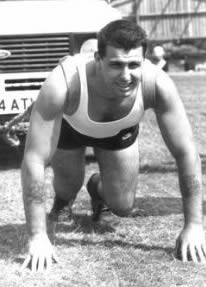 When did you start training?
When did you start training?
My mum and dad got me a 140k weights-set, and a sturdy homemade wooden bench made by my dad, for my 17th birthday. I wanted to put size on so I did nearly every exercise in the booklet that came with the set. Needless to say that not much bodyweight increase happened, even with the raw egg drinks my dad whisked up for me. That alone put me off egg and milk drinks for a long time! But I seemed to be initially strong on feats that required hand strength, as when I was handed a nail to bend at work when some bodybuilders couldn’t bend it, I easily did it and got back to the job of knocking posts in. I trained like this for a while, including a few visits to a local gym, and later gave it up to go out looking for girls! The weights were used here-and-there with brief periods of running till I really got back into training in 1985, aged 23. I have all of my training books right back to this period and it is fascinating to see my progress and what I did right, and what I did wrong!
When did you start competing?
My first strength sport was Tug of War, and I did this from 1986-1987. I really enjoyed this sport, pulling for our local team, and we went from the local farmer and fair’s contests to winning the Federation training league in 1987 and pulling later in AAA’s tournaments. In 1988 I participated in a touring armwrestling event that was using a machine. I did well with this, as not a lot of technique was involved and just masses of side pressure. In 1989 I started to do some All-Round weightlifting contests, where I met up with Steve Gardner who fixed me up with a schedule of strongman contests as I was now weighing 15 stone (210lb). I competed in these regional strongman contests from 1989-1992, with the Midland’s Strongest Man contest being the biggest, but not my best performance, with the likes of Jon Pall Sigmarsson and Jamie Reeves guesting. The All-Round weightlifting went better with wins in 3 International contests. It was in 1990 that I really started to do some grip work with Pinch Lifts, although prior to that I had done plenty of wrist curls. In 1991 I organised the first British Grip Championships under the aegis of I.A.W.A. called the ‘Goerner’. From then on it was grip, grip, grip!
What strength sports have you participated in?
Tug of War (1986-87), Armwrestling (1988-89, 1993, 1999-02, 2005, 2008-), Strongman (1989-1992), All-Round Weightlifting (1989-95) Powerlifting (1989), Grip Contests (1991-2008), Strandpulling (1993).
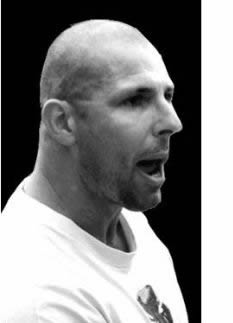 Can you list the major titles that you have won?
Can you list the major titles that you have won?
Champion of Champion Grip Champion 2005
European Grip Champion 2004
British Grip Champion (10 times) 1994, 95, 96, 97, 98, 01, 02, 03, 04, 07.
British Armwrestling Champion 2001
International All-Round Weightlifting Champion 95kg class (3 times) 1990, 91, 92
British All-Round Weightlifting Champion 95kg class (4 times) 1990, 91, 92, 93
Winner of Steve Gardner’s Strongman Series 1991
What are your favourite exercises?
I suppose without a doubt my two favourite exercises that I have done over the years are wrist curls (in any type of style you can imagine), and pinch lifting (with two hands being my favourite). These 2 exercises have been very effective at building a lot of useful hand, thumb and wrist strength, and of course the Pinch Lift is a major part of most modern grip contests. I will always train with gusto on whatever event is in a future contest, especially if it is a weak one; this is the way to win all-round contests by bringing up your weak areas and extending your strong points further. I think that the One Hand Lift and Middle Fingers Deadlift are showy events where big weights are lifted with only one hand or individual digits and I like the feeling you get whilst performing these. In training I like to train at a reasonable tempo.
What type of routine do you tend to follow most, and what do you find most productive?
Goodness me, this is a tough one! Well over the years I have worked on many different exercises, reps, sets, and days of training from 3 days to everyday training. Most programs will be devoted to whatever strength sport I am participating in at that moment and whatever future contest I am training for. I try to peak at the end of a 12-16 week long training program, starting off with lower weight and higher reps or longer holds. This is what I do for my hands and wrists, but for the rest of the body, and I have always trained all body parts, then I have found 3 times a week to be sufficient. And have basically always used the basics, i.e. some kind of squat, deadlift, press, bench press, dips, chins, and curl. Pretty basic stuff! I seem to be very lucky in that I can do daily wrist training, just one of those genetic things.
Recently I was asked about a program for beginners.
Here is that ‘First Workout For Beginners, Gain a strength base with no injuries’ program. I seem to be seeing a lot of beginners jumping into all sorts of feats of strength, including bending before they have got any real base strength in the hands and wrists. This is what I would advise to the pure beginner to start with, for a good few months before he/she decides on the path they want to choose. I think this will stop a lot of injuries that are happening due to imbalances between certain areas.
Exercises
1. Two Hands Pinch Lift for holds, also use work gloves to protect your skin.
2. Finger curls with an Olympic Bar, overhand grip. Hold it on the last set when you can't do anymore finger curls.
3. Two Hand Wrist Curl. Normal, with a comfortable range of motion. Do not let the bar go into your fingertips like some bodybuilders do, also do them with your thumb under the bar as you are training your wrists and don't want to fight against the thumb digit on top of the bar.
4. Two Hands Reverse Wrist Curl.
Do the Pinch holds for 10-15 seconds, and the other exercises for 15-20 reps.
These were some questions I got asked.
1. How often?
I would do them 3 times a week if you can, but twice a week if struggling with this.
2. How many sets of each?
I would say 3 sets per exercise, which you should easily do quickly. If this is a struggle then go down to 2 sets.
3. What about crushing?
The 'crushing' exercise is Finger curls with an Olympic Bar, overhand grip. This is an easy exercise to learn for the beginner and doesn't have the techniques of setting, etc. Grippers can be brought in later when they want to excel at this implement.
4. Why the gloves with pinching?
You can easily tear the skin in between the index finger and thumb, which would put you out of action, especially since you will be pinching 3 times a week. This initial program for the beginners is all about strengthening, and the gloves will make it a tougher exercise, but safer for the skin.
5. Should you do all these exercises on one day?
Yes. In the order I stated.
Hopefully this will help some beginners out there, it’s also a good routine even for advanced athletes.
You have invented many pieces of grip apparatus and events. Please tell us about them.
Over the many years of running the grip contests I have had to come up with many events, as we used to change most of the events yearly. I would resurrect lifts from the past if I thought they could be refereed well, this was a priority for me, and if they couldn’t be then I would invent an event that fitted the bill. All the events that I have ever used in a contest or written about in training articles have been well and truly tested by me, the guinea pig.
OrbiGrip -- I developed this machine to strengthen my wrists, forearms and hands. It builds good size on your forearms, and is also excellent for rehab and prehab.
Vulcan Hand Gripper -- I developed this machine to help with my crushing strength. I wanted an adjustable gripper, so that I could increase the resistance gradually.
Bending Machine/Wrist Developer -- I developed this machine this year to help me train workload and reps on my Reverse Bending Challenge. It has really paid off and leap-frogged me up to some serious bends.
One Hand Vertical Bar Lift – This exercise was first advocated using a swinging motion between the legs, in a 1943 article by Norman E. Morris (H&S May 1943), to help with the One Hand Swing. I made a bar in 1993 and used it as a ‘supporting grip’ test of strength. The lift made its debut in the 1994 Grip Championships. A standard bar (‘LGC’ Lodekopinge Grip Contest) has now been introduced and made by Arne Persson of Sweden and is now being used in international contests.
Table Top Wrist Curl – This event, was just an easier way to referee the normal wrist curl. With this event all you had to do was flex your wrists till your knuckles and hands came off the table. Sounds easy, until big weights are placed in your hands!
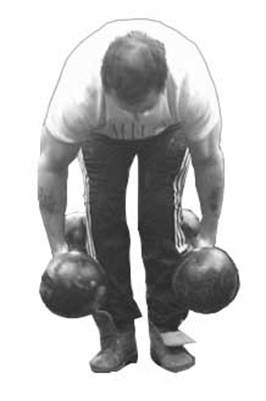 Bear Hug Deadlift – This was an exercise that I devised back in 1997 to help with the oncoming trip to Scotland to lift many of the famous stones of strength, particularly the Blue Stones of Old Dailly, and the Inver Stone. I now see that this exercise has become the norm for people training on round stone lifting.
Bear Hug Deadlift – This was an exercise that I devised back in 1997 to help with the oncoming trip to Scotland to lift many of the famous stones of strength, particularly the Blue Stones of Old Dailly, and the Inver Stone. I now see that this exercise has become the norm for people training on round stone lifting.
Challenge Bars – We needed a ‘test of wrist strength’ for the 2004 European Grip Championships so Mikael Siversson and I decided on non-braced bending as an event. I then got a company who would get me same batch steel bars of 6mm and 8mm Cold and Hot Rolled Steel and cut these into quarter-inch length increments between 7 ½”-5 ½”. Every new stock was calibrated using the Tom Black method of hanging the weight in the middle of the bar and deadlifting it up till it bent to the right angle. The toughest bending stock of 8mm came in at 390k, this was a special batch that was never replicated again.

Wrist Curl Machine – This is a lovely smooth machine that has been made using my specifications by a company I deal with. It has a 42mm handle that is on a self-lubricating bush. It is easy to adjust the height with any size bar and weights fitting at the bottom. This machine negates the need for a bar to be handed to you, so you can train safely on your own.
Adjustable Pinch Lift apparatus – Once again Mikael Siversson and I needed another event for the European Grip Championships, this time an adjustable Pinch Lift. By using inner hard rubber discs to alter the width to what you require, and standard steel plates for the outsides, this was achieved, as well as keeping the same ‘look’ of a plated Pinch Lift.
Supination/Pronation machine – My first prototype was a spade shaft on top of two squat stands with weights hanging in the middle. By turning the handle like a key back and forth you would train the supinators and pronators. Later a steel bar, with a cam principle was made and it is this that we still use today.
Dinnie Rings – On my first visit to lift the Dinnie Stones I took all the measurements of the stones and the rings. We have made a replica of the large stones ring in the past, and in fact used it as an event in the 2003 Grip Champs and also gave replicas as trophies that year.
Armwrestling training – We use a nice leverage 'Lock' exercise which helps to build the strength needed in this position.
Have you ever injured yourself whilst lifting?
My worst injury whilst lifting was at the British All-Round Champs on my birthday in 1993. This was on the last event of the day the Hand and Thigh, which is a short-range deadlift. I was going for 600k on my 2nd attempt and was pushing through my feet when I heard an almighty crack (like a bat being broken) and I fell to my right. At first I wasn’t sure if it was the chain apparatus that had snapped or something, but upon standing, I realised that my leg was swelling quickly and now turning inwards. I have this lift on video and it’s a right ‘video nasty’! I was taken to hospital straight away where I was diagnosed with a hamstring rupture, Rectus Femoris and Vastus Medialis tears and damage to my kneecap and cartilage. Surgery, and rehab followed, but it really took a year to be fine again. Not a great birthday present!
The year before, whilst doing some individual finger lifts with a ring I ripped the webbing between my little finger and ring finger. I was lifting 90k with my right little finger when I heard ‘rip’ and looked down to see my finger tendons between all the blood. I quickly ascertained that the tendons were fine, but I still needed a visit to the hospital. The doctor whilst stitching me was somewhat amused, and probably recounts the story of the ‘nutter’ who tore his finger many times! My worst injury actually came about when the stem of a swivel chair I was sitting on snapped, this put paid to my deadlifts and squats from then on, and also a lot of pain to boot, even now some 5 odd years later. A shoulder injury I incured in 2005 is soon to be sorted out as I have surgery on Dec 12th.
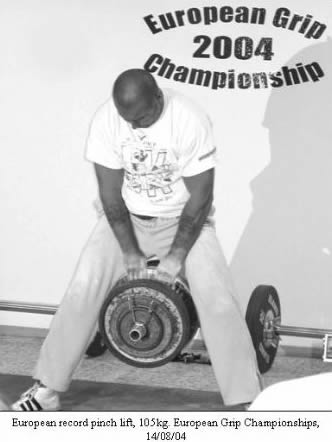
Which feats and records are you most proud of?
In grip strength my some of my favourites are:
Two Hands Pinch Lift on the adjustable Euro apparatus of 110.8k, 11/8/05.
Tore 2 packs of cards in half (jokers included), 108 cards. 27/7/95. This was hard, and whilst doing it blood spurted from under the nail of my little finger!
Lifted the Dinnie Stones together (total weight 785lb) 3 times, also lifted the large 440lb stone with one hand for 20 consecutive reps, [all with no hook grip]. Done at Potarch on a wet day 5/4/98 in front of David Webster and Gordon Dinnie.
One Hand Pinch Lift of 67.5k L/H. 12/6/01
One Hand Lift (with no hook grip) 335k [1” lift] 28/7/01
Table Top Wrist Curl 302.5k 3/8/02.
I have also deadlifted and held for time the Inch Dumbell, deadlifted the 50lb Blob and pinched 2 x 20k discs in one hand. But I’ve always been more pleased by a contest win rather than a record. In fact gaining podium positions should be the interim short-term goal on the way to the big one. I’m even pleased with my 11th of 23 in the World Armwrestling Champs in Poland 2001, as it’s hopefully the first stepping-stone to something better.
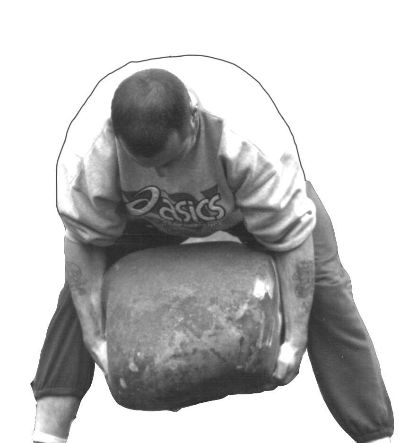 Have you ever had a go at any stones other than the Dinnies?
Have you ever had a go at any stones other than the Dinnies?
On the visit to Scotland with my friends Nick McKinless, Lee Morrison and Mike Thompson to lift the Dinnie Stones, we also took in a few other stones. Two days prior (3/4/98) in Old Dailly I Bearhug deadlifted the large blue stone of Old Dailly (pictured right), which is very smooth (glass-like), and weighs around 320lb for 10 consecutive reps. After the successful lifting of the Dinnies on the 5th of April and a glass of Guinness with David Webster and Gordon Dinnie we made ourway to the Inver Stone. After clearing the snow off it, I lifted the 265lb stone to chest height. The toughest stone I ever tried to lift was the ‘Blue Stone of Old Hartley’, made famous by Willie Carr. This came about on the 24th May 1999, when my son Jason and I went to Old Hartley in the north east of England for a pre-arranged attempt at this formidable stone. The council had taken this special stone out of its concrete moorings for this occasion and the BBC North East radio station was even there to record it. This is a very smooth, once again glass-like stone, and weighs around 400-440lb, and to make it even tougher it weighs off-centre to the right and back side. I failed my first 4 attempts, being unable to get the balance right, as there was very little to grip onto on the right side. The fifth attempt was going to be my last attempt anyway, so I wedged my hand further back, and took the brunt of the stone on my right wrist and went for it. The front once again came up first but this time I felt the sway as the back came up and the stone hovered for a very short period, with shouts of ‘it’s up’ being heard. I was very pleased and proud with this achievement. I didn’t take my training belt off for about an hour, I was absolutely shot!
Can you tell me about your armwrestling career?
As I said earlier in 1988 I participated in a touring armwrestling event that was using a machine, this was just a push sideways event. My real armwrestling baptism came in 1993 when I participated in the British champs in Ilford getting knocked out quickly, and with no armwrestling training it’s no wonder this happened. Later in 1999 I came back and with some tips gleaned from a visit to the very good armwrestler Neil Pickup under my belt, and with a proper table to train on I did a lot better. I came 4th in the British in 1999, followed by a 2nd the year later and finally a win in 2001, where I beat Chris Andrews in the final. I qualified for the World’s in Poland and came 11th of 25, which was pleasing since I hadn’t really done any training for it.
Who particularly impresses you, and in what areas?
Well when I was getting really interested in the grip side of strength I tried to read everything about it. There really was very little around except for a few books (David Gentle & David Webster’s was one), and other older booklets. I would purchase various bodybuilding magazines just for articles by these two famous authors, and really it is this interest that lit my fire. When I read about the old timers I was most (and still am) impressed by ‘Apollon’ Louis Uni and Herman Goerner. These fine athletes stand out with their immense hand strength. Some others haven’t stood the test of time so well when their feats were put under scrutiny. At the end of the eighties and beginning of the nineties the I was reading about Ronnie Tait and Paul Shaw in the UK (both of whom I have met), and Richard Sorin and John Brookfield in the U.S. Richard and I have corresponded for many years and I believe he was the first super grip athlete to arrive on the scene, since Goerner, although Mac Batchelor and Slim Farman could have reached that height if they had done a greater variety of grip feats. How things have changed from when Richard Sorin became the first person to close a #3 CoC gripper in 1991. For 4 more years only 2 other athletes joined that list, and at the same time in the U.K. our grip contests were gaining more popularity with athletes coming from many strength fields. I’ve always been impressed with athletes who have not only used their brawn but their brains as well. In my early days I remember Geoff Capes dissecting events and doing very well at them even though he was not the strongest in the field. I followed this approach, and would go over and over events to see what was working and what wasn’t. This approach was undertaken by two pupils of mine who I admire greatly for their skills, strengths and doggedness. These are Nick McKinless, and Elizabeth Talbot who has some incredible genetics, and who produces the greatest feats year in year out. Last year’s performance, with the men in the European Champs was mind-blowing. Without a doubt, the greatest female grip athlete so far! Now we come to the modern guys, and these guys are competing, and with this competitive edge they are breaking down barriers fast. In Europe Benny Wennberg and Martin Arildsson of Sweden, and David Hurzeler of Switzerland stand out so far. In the U.S. previous champs like Steve McGranahan, Rob Vigeant, Jedd Johnson, Tommy Heslop, and Dave Morton, are mixing it with the now new guys Chad Woodall and Dave Thornton. In the bending world Pat Povialitis is still #1 and bending even crazier stuff, but guys like Dave Morton, Greg Amidon and a few others are right there as well, whatever the style of bend that is undertaken we all know that even crazier feats are just around the corner.
What are some of your favourite items in your strength memorabilia collection?
Regarding my collection of grippers, the last installation of what it consists of is featured in this issue. I suppose the Iron Man non-knurled grippers from the 1970’s, given to me by Joe Roark, and the Charriere hand dynamometer from the 1870’s, which is incredibly rare and may be the only one known to exist now. In my bar and nail collection, they are all special, but I suppose the horseshoes bent by Pat Povilaitis and the wrench bent into a pen holder by Dennis Rogers are items of destruction that are beautiful to the eye, and I thank these great strongmen for their kindness. I will also include a full list of this collection later in this issue. My books and magazines are a working library that has taken me years to slowly build up. I have helped many people do research with this collection, including someone’s whole dissertation for their degree. This was great fun, and his published book now sits in the collection. Obviously items such as posters and handbills may be a one of a kind. I also have a lovely collection of old postcards from the beginning of the last century; many of these are on show in my house. I am lucky to have a good collection of Health and Strength and La Culture Physique magazines from the 1900s, a favourite period of mine. For anyone getting interested in the old-time strongmen then the books ‘Anvils, Horseshoes and Cannons’ by Leo Gaudreau, ‘Sons of Samson’ and ‘Barbells and Beefcake’ by David Webster are must-haves. ‘The Amazing Samson’ by Alexander Zass & W.A. Pullum, and ‘The Mighty Atom’ by Ed Spielman are great reads.
If you could go back in time and meet just three strong men or women, who would they be and why?
Wow, great question! I’ll just pop into my time machine and head to Desbonnet’s gym in Roubaix, France in the 1890’s and see Louis Uni perform one amazing feat after another, well unless he’s in a lazy mood. Then I’ll have to goad him into doing something, maybe if I arm wrestle him and beat him this will infuriate him enough to man-handle every thick-handled dumbbell and barbell on show!
My next port of call would be Leipzig, Germany on the 8th of October, 1920 to see Herman Goerner’s One Hand Deadlift of 330k. It would be nice to stay around for a few weeks and train with Herman on his many exercises, and see his official One Hand Deadlift three weeks later on the 29th with 301kg.
Thirdly I would go back to before my dad died in 2003 and spend as much time with him as the time machine would allow me to, and give him an even bigger hug than our last one.
You have introduced a lot of people to weightlifting and grip sports. What is it that drives you to do this?
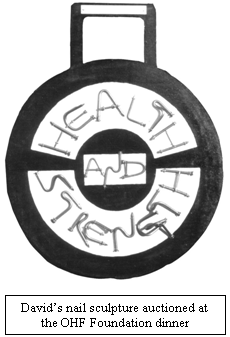 Yes I have. There have been many, and some of them incredibly gifted inthis area, and others just plain hard workers. I have to admit that I get a kick out of watching the lesser athlete do something they deem to be impossible for them, rather than a genetically gifted half-arsed attempt, even though it’s a bigger lift. I have been lucky, because I have also benefited from training all these people,because they create enthusiasm, which in turn powers you through hard training sessions. Also this feedback system helps with the exchange of training ideas, whether in the gym here in Stafford, or through the old Iron Grip courses, Iron Grip magazine, or contests. What comes around goes around!
Yes I have. There have been many, and some of them incredibly gifted inthis area, and others just plain hard workers. I have to admit that I get a kick out of watching the lesser athlete do something they deem to be impossible for them, rather than a genetically gifted half-arsed attempt, even though it’s a bigger lift. I have been lucky, because I have also benefited from training all these people,because they create enthusiasm, which in turn powers you through hard training sessions. Also this feedback system helps with the exchange of training ideas, whether in the gym here in Stafford, or through the old Iron Grip courses, Iron Grip magazine, or contests. What comes around goes around!
Have you got any goals that you still want to achieve?
In armwrestling I have many goals. In grip contests I may come back into competing, just depends on a few things, but I'm happy right now building the sport of grip's profile and training. Outside of sport, I just want to be happy with Elizabeth and my family.
Any words of advice for our readers?
This ‘grip thing’ will develop stronger hands and wrist, but will not make you a strong man. Try to be a good person, and true, then people will see that you are indeed a strong man. Life is a short journey so enjoy it, and enjoy it with others.

